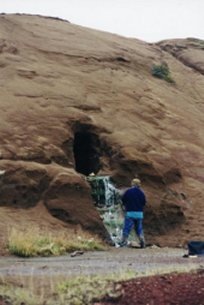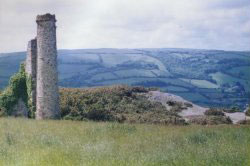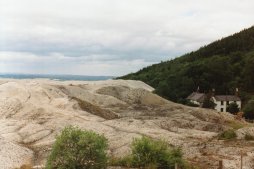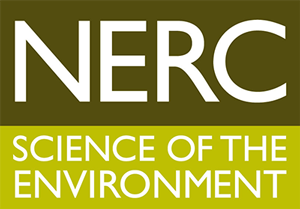Legislation & policy: mine waste
Introduction to the problems of mine waste in the UK
Britain is remarkably well–endowed with mineral resources, the type and distribution of which are related to the complex geological and tectonic history of the British Isles and the adjacent continental shelf. The most important mineral worked in the past, in terms of value and effect on the environment, is coal. More then 26 000 Mt have been extracted from thousands of mines in many areas, together with an estimated 3 600 Mt of waste rock. [Click here to view information on the Coal Resources Map of Britain]. There have been numerous environmental problems associated with coal mining. The most common, and costly, is subsidence causing damage to property which has to be remediated. Others include waste tip stability and environmental pollution. Remediation of colliery waste tips has been on–going for many years and many tips have been restored to productive use. There is also a growing problem of rising acid minewater as more mines are closed. Mine waste is called ’Mineral working deposit‘ in the Town and Country Planning Act 1990 and is defined as ’any deposit of material remaining after minerals have been extracted from land or otherwise deriving from the carrying out of operations for the winning and working of minerals, in on or under the land‘.

Non–ferrous metal mining has been concentrated in relatively few areas. [Follow this link for further information on exploration in the UK]. The most important has been the south–west England mining district where over 2.5 Mt of tin metaland 2 Mt of copper have been produced from a large number (several thousand) of mines working major fissure veins associated with Variscan granite intrusion. The most important area was centred on Camborne and Redruth. Around 6 or 7 Mt of lead has been produced from the Northern and Southern Pennine Orefields of northern and central England and also North Wales from thousands of vein deposits in Lower Carboniferous carbonates. Up to 50 000 mineshafts are estimated to have been sunk in the Southern Pennine Orefield alone, together with hundreds of adits. Lead–zinc veins have been worked in Lower Palaeozoic greywackes in the Central Wales, Lake District, Shropshire, Leadhills and the Isle of Man mining fields. Large amounts of iron–ore have been produced from the low–grade (20 to 30% Fe) Jurassic ironstones of central and eastern England (over 1100 Mt), the Carboniferous hematites of the Lake District and South Wales (about 200 Mt) and the ironstones of the Coal Measures (about 200 Mt). [Follow this link for further information on exploration in the UK]. This historical production of ferrous and base metal ores and their resulting waste tips has resulted in a number of environmental problems, including the chemical pollution of streams and aquifers by heavy metals, such as Cu, Pb, Zn and As, as well as acid mine drainage and visual pollution by ferruginous deposits associated with the waste. Further information on the historical production of metals in Britain can be found on the free downloads page.

There has been considerable production of industrial and Constructional minerals from quarries or underground mines. Building stones and slate have been worked wherever suitable rocks occur. The most important environmental effect is generally visual. This is particularly true in slate and china clay mining which had waste / ore ratios exceeding 10 / 1 at times. This has led to the development of major waste rock tips in North Wales, often in areas of high relief and scenic value, which causes problems of stability and visual amenity. In Cornwall the china clay waste tips were formerly conical features on an otherwise flat landscape and are now levelled. Salt has been mined by underground and uncontrolled solution methods in Cheshire for hundreds of years causing major problems of subsidence. Modern methods of salt extraction do not cause subsidence. Brick clays have been worked in many areas. Large open pits remain in some areas.

The state of knowledge regarding mines and quarries in Britain is very variable. The locations of all current or recently closed mines and quarries are well known, though specific output statistics are generally confidential. [Follow this link for information about the Britpits Quarry database]. The location of many other abandoned mines and quarries are also known [follow this link to go to the Mineral Occurrences database page], but there may be very little information on the mineral production and even less on the waste generated (size, content, effects on the environment). The Mining Instability study by Ove Arup in 1991 represented the first national survey of all types of mining and their effects on the stability of the environment. It did not cover geochemical, particulate or visual aspects of mineral extraction and did not cover any aspects of waste production and subsequent management. The BGS published a report in 1995 on the extent of potentially harmful elements from natural and mining sources (British Geological Survey Technical Report WP/95/3).
Legislation governing mine waste management in the UK
In Britain legislation is enacted by Acts of Parliament, which set out the general areas addressed by the legislation. These are further refined by Regulations, which explain, extend or amend the parameters to which the relevant Act will apply. Legislation governing the mining industry has grown over the years, often following a major event or disaster, which has led to calls for specific legislation to control or eliminate certain operations within the industry. Until recently, legislation was mainly concerned with the working environment of the pit or quarry and little heed was paid to the environmental consequences of mining. Almost all land, including the mineral rights, was privately owned and there were few regulations governing the environment beyond the actual mine site. The early legislation in the nineteenth century provided a safer working environment for the miners with the introduction of regulations regarding the control of ventilation to prevent gas explosions and restrictions on the employment of young people and women. As the mining industry grew and prospered additional legislation was introduced to ensure the provision of working mine plans, mine abandonment plans and the creation of a Mines Inspectorate to enforce the regulations.
The first serious attempt to control the environmental consequences of mining, apart from local initiatives to control a specific nuisance, was in respect of the Jurassic ironstone workings in the East Midlands. These were the first large–scale mechanised opencast workings in Britain and produced a major alteration of a smooth agricultural landscape to alternating hill and valley topography. Following the report of the Kennet Committee, which was set up in 1938, and the Waters Committee in 1946, the Mineral Workings Act 1951 was passed. This set up the Ironstone Restoration Fund which was based on producers and mineral rights owners contributing a per ton raised fee from which they could draw to pay for subsequent restoration of currently and previously worked land.
Opencast coal operations did not require formal planning consent until the Opencast Coal Act 1958 and The Town and Country Planning Act 1962, which authorised the then Department of the Environment to make the planning decision. This removed it from the control of the local authority. The 1958 Act was concerned with authorising the activity of opencast coal working, including the rights of surface owners, compensation for loss of land and rights of way. It did not address any environmental aspects.
The environment is therefore a recent addition to legislation governing mines and quarries and their attendant waste tips. Interest in this subject has grown in Britain since the Aberfan disaster of 1966, which led to the passing of The Mines and Quarries(Tips) Act 1969. This states that it is 'An Act to make further provision in relation to tips associated with mines and quarries; to prevent disused tips constituting a danger to members of the public; and for purposes connected with those matters'. This Act is an extension of The Mines and Quarries Act 1954 which did not mention tips specifically in its provisions. In fact, the only reference in the 1954 Act to the safety of the public beyond the mine or quarry is a section dealing with the fencing of abandoned and disused mines and of quarries. This was designed to prevent people falling into mines, not to stop the adjacent tips falling on them. The Aberfan disaster was, in fact, not required to be formally reported under the 1954 Act. The detailed requirements to implement and comply with the 1969 Act are laid out in The Mines and Quarries (Tips) Regulations, 1971. Subsequently The Quarries Regulations 1999 state that tips must be designed, constructed, operated and maintained so that instability or movement likely to cause risk to the health and safety of any person, is avoided. They also specify the geotechnical and other measures to be taken to ensure this. Other legislation which may have some bearing on the construction, operation and disposal of mineral waste tips include the Rivers (Prevention of Pollution) Acts and the Clean Air Acts.
As well as the legal framework for the health and safety of workers and local residents, and the environment, there is a planning framework. As in other developed countries, Britain is subject to planning controls governing most forms of ‘development’ of land, including mining activities, under the guidance of the Ministry of Housing, Communities and Local Government (MHCLG).
Oil and gas
The UK Continental Shelf (UKCS) comprises those areas of the seabed and beneath the seabed, beyond territorial waters (12 mile limit), over which the UK exercises sovereign rights of exploration and exploitation of mineral resources (excluding hydrocarbons).
ownership of oil and gas within the land area of Great Britain was vested in the Crown by the Petroleum (Production) Act 1934. The Continental Shelf Act 1964 applied the provisions of the 1934 Act to the UKCS outside territorial waters.
For landward exploration a licence is required, which grants exclusive rights to exploit for and develop oil and gas onshore within Great Britain. The rights granted by landward licences do not include any rights of access, and the licensees must also obtain any consent under current legislation, including planning permissions. The Department for Business, Innovation and Skills grants licences to explore for and exploit all oil and gas resources. Licensees wishing to enter or drill through coal seams for coalbed methane and coal mine gas must also seek the permission of the Coal Authority.
Coal
Following the privatisation of the coal industry in 1994, the ownership of almost all coal now resides with the Coal Authority who grant licences for coal exploration and extraction.
The Coal Authority is a non–departmental public body, which in 1994, assumed responsibility for all the interests in respect of unworked coal and coal mines and for the liabilities associated with past coal mining and unworked coal. The main functions of the Coal Authority are to manage the coal resources under its control, encourage economically viable operations to work these resources, grant licences for coal exploration and extraction, provide effective management of subsidence damage claims, and provide information on past, present and proposed future coal mining activities.
Gold and silver
The Crown holds the rights to gold and silver. This is the case across the whole of the UK although in the past, in Scotland, some rights were transferred by ancient charter. The mines of these metals are known as ‘Mines Royal’. A licence, known as a Mines Royal Licence, for the exploration and development of these metals must be obtained from the Crown Estate Mineral Agent, Wardell Armstrong.
Other metallic and industrial minerals
Other minerals are in private ownership, and although there is no national licensing system for exploration and extraction, planning permission must be obtained from a mineral planning authority for their extraction.
UK onshore – Northern Ireland
The Mineral Development Act (Northern Ireland) 1969 vested most minerals in Northern Ireland in the Department of Enterprise, Trade and Investment (DETI). This enables the DETI to grant prospecting and mining licences to commercial companies for exploration and development of minerals. There are three main exceptions:
- gold and silver, as they are already vested in the Crown
- minerals which were being worked at the time of the 1969 Act. Specific minerals in several small areas are involved
- ‘common’ substances, including aggregates, sand and gravel, are excluded.
Further details can be obtained from the Geological Survey of Northern Ireland.




Follow us

